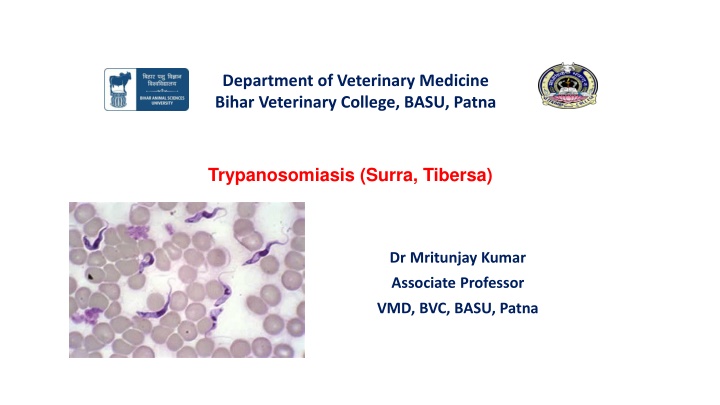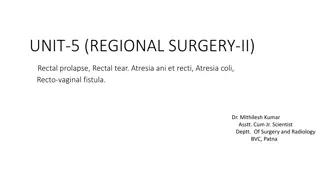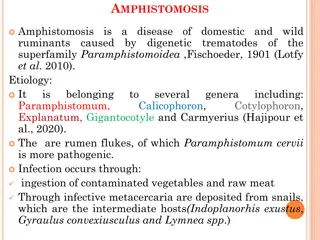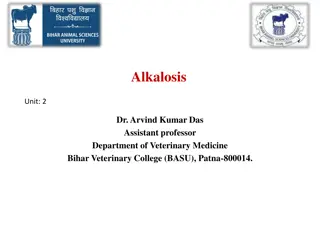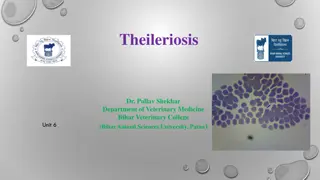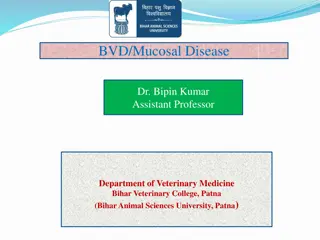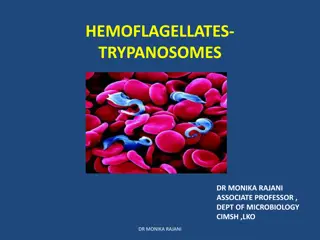Trypanosomiasis in Cattle and Buffaloes
Infectious progressive anaemia, oedema of dependent parts, and loss of condition are key characteristics of Trypanosomiasis in cattle and buffaloes caused by Trypanosoma evansi. The disease, commonly known as Surra, has varying clinical presentations from peracute to chronic forms. Cattle and buffaloes may exhibit symptoms like convulsions, staggering gait, blindness, circling movements, and ultimately death in severe cases. Additionally, animals may show signs of emaciation, fever, anaemia, oedema, and progressive deterioration in health. Understanding the clinical findings and transmission modes is crucial for effective management and control of Trypanosomiasis.
Download Presentation

Please find below an Image/Link to download the presentation.
The content on the website is provided AS IS for your information and personal use only. It may not be sold, licensed, or shared on other websites without obtaining consent from the author.If you encounter any issues during the download, it is possible that the publisher has removed the file from their server.
You are allowed to download the files provided on this website for personal or commercial use, subject to the condition that they are used lawfully. All files are the property of their respective owners.
The content on the website is provided AS IS for your information and personal use only. It may not be sold, licensed, or shared on other websites without obtaining consent from the author.
E N D
Presentation Transcript
Department of Veterinary Medicine Bihar Veterinary College, BASU, Patna Trypanosomiasis (Surra, Tibersa) Dr Mritunjay Kumar Associate Professor VMD, BVC, BASU, Patna
Infectious progressive anaemia, oedema of dependent parts and loss of conditionfollowed by terminal nervous signs Aetiology Surra is caused by Trypanosoma evansi Morphologically, T. evansi are 15-34 m in length, 1.5-2.5 m in breath and pleomorphic The parasites occurs in vertebrates mainly in the blood and tissue fluids as intercellular parasites Epidemiology Surra was first reported by Sir Griffith Envas in 1818 in India in the blood of horses and camels in the area known as Dera Ismail Khan (Pakistan) Hot or warm and temperate climates and widely prevalent in Africa, Mediterranean, Arabian, Middle Eastern, South Asia and far eastern countries disease characterized by intermittent fever,
Camels, horses, donkeys, mules, cattle, buffaloes, elephants, pigs, dogs, cats, sheep, goats and a wide variety of wild animals are usually affected The maximum cases of trypanosomiasis are observed in rainy season and post monsoon months when the vector density is quit high through latent cases are encountered throughout the year Mechanical transmission-Horse flies of genus Tabanus, Stomoxys, Haematopota and Lyperosia The interrupted feeding behavior of these insects helps in carrying the trypanosomes infected blood between members of herds of livestock Indian crow which pecks at the animal wounds can also transmit the infection At the time of vaccination during outbreaks when the sterilization precautions are not adequately exercised. Oral penetration by T. evansi is also suggested as one of the mode of transmission
Clinical findings Cattle and Buffaloes: The incubation period is 6 to 14 days and course varies from symptomless carrier to a per-acute infection The symptoms vary in per-acute, acute and chronic cases. Peracute form: Animals die within 2 to 3 hr of showing nervous symptoms like convulsion Acute form: Animals appear dull and sleepy with staggering gait, eyes staring and wide open, with rise in body temp. to 1050F Difficult breathing with effort and noise, nervous excitement and animals strikes or beats hard against the wall and mangers Apparent blindness, circling movements, stumping of feet, bellowing, frequent micturation, twitching of muscles and shivering of body followed by coma, collapse and ultimately death within 6 to 12 hours profuse salivation,
Sub Acute and Chronic form: Animal appears dull and sleepy and there is bilateral lacrimation. Progressive emaciation, rapid pulse, intermittent fever, progressive anaemia, oedema of legs, diarrhea, loss of body condition, nasal and ocular discharge and death from exhaustion Pregnant animal may abort The disease has long course of 16-64 days Cattle and buffaloes act as carrier state was reported upto 190 days in buffalo calves Equines, mules and donkey: Intermittent fever, progressive weakness, anaemia, emaciation and odema of dependent parts of the body Urticarial plaques may appear in neck and flank Loss of condition despite of good appetite, difficulty in walking, lacrimation, conjunctivitis, hypertrophy of superficial lymph nodes and ascites The nervous signs like paraplegia, paralysis and convulsion occur only in terminal stages of disease Camel: Surra usually occurs in acute, sub-acute and chronic form.
Acute form: It occurs just after monsoon season and animal suffers from high temperature (3-40F) haemorrhages of mucous membrane There is intense anaemia, drooping hump and affected animals unable to walk long distance Oedema may develop in the legs, brisket, under the belly and eyelids The is sudden death and the rate of mortality may reach 50% or above above normal and pachy Chronic form: It is associated with progressive anaemia, emaciation, intermittent fever, alopecia, oedema of dependent parts and abortion in pregnant animals The name tribersa in India indicated the duration of disease as 3 years Dog: Fever, anorexia, pale conjunctiva, oedema of head and thorax, corneal opacity or even blindness Cat : Chronic cases reported and these may some times be fatal
Pathogenesis The trypanosoma is inoculated into the host via contaminated mouth parts of biting flies The parasites multiply in blood and body fluids including the cerebrospinal fluid and cause inflammatory changes and anaemia It causes severe organ damage particularly in horses, camel, cattle, buffaloes, elephant, dogs, small ruminant and occasionally in pigs Trypanosoma can also pass through the placenta - abortion and pre- mature calves birth in some cows A cerebral form of disease can occurs sometimes even after successful treatment because trypanosomes are protected through commonly used chemotherapeutics agent in brain and cerebrospinal fluid by the blood- brain-barrier Such trypanosomes are believed to be source of some relapsed infections
Clinical pathology Microcytic hypochromic anaemia characterized by reduced Hb, PCV and TEC , hypoglycaemia, hyperkalemia Necropsy findings The carcass is emaciated, pale and may be icteric but there are no pathogonomic gross and microscopic lesions like spenomegaly, enlargement of lymph nodes and kidneys, leukocytic infiltration of liver parenchyma and petechia haemorrhages Diagnosis Prevalence of biting flies and symptoms like progressive emaciation, anaemia, oedema and paleness of mucous membrane Microscopic examination: Blood collect at height of temperature are positive for trypanosomiasis Dark field/phase contrast microscopy: Motile trypanosome may be observed Laboratory animal inoculation: The suspected blood or lymph nodes aspirate or CSF can be inoculated in laboratory animals like rat, white mice, guinea pigs, rabbits and dogs by intra-peritoneal or subcutaneous route Parasitaemia-4-5 days post inoculation while in dogs it occurs after 7 days
Chemical test: Less reliable than animal inoculation test a) Mercuric chloride test: Reliable for detection of surra in camel. A drop of test serum is added to 1 ml 1:20,000 solution of mercuric chloride. In positive case (after 2-3 weeks generally) white precipitate is produced. b) Stilbamidine test: Reliable test for detecting surra in bovines. About 0.5-2.5 ml of freshly prepared 10% of stilbamidine is taken in agglutination tube and one drop of suspected serum (inactivated at 560C) is added. A positive case shows coagulation which begins to settle down in 30 sec and dissolves in 5-10 min. c) Formalin gel tube test: Reliable in camel and equines. 2-4 drops of commercial formaldehyde solution is added to 1 ml of suspected serum and tube is shaken and allowed to stand. In positive case gel formation occurs within 2-4 hours. d) Thymol turbidity test: It is used in camel and one drop of suspected serum is added to 1ml of aquous thymol solution having a concentration of 1:100 to 1:2000. In positive cases white turbidity appears within few minutes. e) Antigen detection through ELISA is more reliable and can detect trypanosomal concentration of protein upto 1.5 g/ml. Other tests like indirect fluorescent antibody, gel diffusion, card agglutination etc are helpful in confirming the disease.
Differential Diagnosis 1. Nervous form may differentiated from Polioencephalomlacia and nervous form of ketosis 2. Babesiosis, Ehrlichiosis, Theileriosis, Parasitic infestation and hypoproteinaemai Treatment: Commonly used drugs for trypanosoma 1. Quinapyramine sulfate (3-5mg/kg s/c) Horses, camels, pigs, dogs T. vivax, congolense, brucei, evansi, equiperdum, simiae Curative and Prophylactic 2. Diminazene aceturate (3.5 to 7mg/kg im) Cattle T. vivax, congolense, brucei Curative Curative
3. Homidium bromide(1mg/kgim) Equids T. vivax Curative, some prophylactic activity 4. Isometamidium chloride (0.25-1mg/kg, iv or deep im) Cattle T. vivax, T. congolense Curative and prophylactic 5.Suramin(7-10mg/kg iv) Horses, camels, dogs T. brucei, T. evansi Curative, some prophylactic activity
6. Melarsomine dichlorhydrate (0.25-0.5 mg Camels T. evansi Curative 7.Quinapyramine dimethylsulfate Horses, camels, pigs, dogs T. vivax, T. congolense, T. brucei, T. evansi, T. equiperdum, T. simiae Prophylactic Supportive therapy Symptomatic treatment for anaemia, oedema, pyrexia etc.
Prevention and Control: Vector flies can be partially controlled - Spraying and dipping of animals, aerial and ground spraying of insecticides on fly-breeding areas, us of insecticide-impregnated screens and targets, bush clearing, and other habitat removal methods Animals can be given drugs prophylactically in areas with a high population of trypanosome-infected tsetse Monitoring of drug resistance by frequent blood examinations for trypanosomes in treated animals. Several breeds of cattle and water buffalo have been identified that have innate resistance to trypanosomiasis and could play a valuable role in reducing the impact of the disease in these areas Control is ideally achieved by combining methods to reduce the fly challenge and by enhancing host resistance with prophylactic drugs.
Dourine Dourine is a chronic venereal disease of horses that is transmitted during coitus and caused by T equiperdum The disease is recognized on the Mediterranean coast of Africa and in the Middle East, southern Africa, and South America Clinical Signs It may develop over weeks or months Early signs include mucopurulent discharge from the urethra in stallions and from the vagina in mares, followed by gross edema of the genitalia Later, characteristic plaques 2 10 cm in diameter appear on the skin, and the horse becomes progressively emaciated Mortality in untreated cases is 50% 70%. Infected horses can be detected with the complement fixation test but only in areas where T evansi or T brucei are not found because they have common antigens. An ELISA test may become available for diagnosis.
Chagas Disease Chagas' disease, or American trypanosomiasis, is a zoonotic, vector borne disease transmitted by triatomine bugs and caused by T cruzi All mammals are considered susceptible to infection, with infection demonstrated in >100 mammalian species. Avian species are not susceptible The disease is best recognized in dogs and people, with dogs serving as a major domestic reservoir Domestic pigs and cats can also be infected, but their role as reservoirs for human infection is limited Wildlife reservoirs include opossums, armadillos, raccoons, woodrats, and nonhuman primates Tsetse-transmitted Trypanosomiasis This group of diseases caused by protozoa of the genus Trypanosoma affects all domesticated animals The major veterinary species are T congolense, T vivax, T brucei brucei, and T simiae. T brucei rhodesiense and T brucei gambiense are zoonotic, with people as the predominant host
Q. Choose the most appropriate answer 1. Which species of Trypanosoma is primarily responsible for Nagana in cattle? A) Trypanosoma brucei rhodesiense B) Trypanosoma cruzi C) Trypanosoma evansi D) Trypanosoma brucei brucei 2.What is the main vector responsible for the transmission of Trypanosomiasis? A) Ticks B) Mosquitoes C) Tsetse flies D) Sandflies 3. Which of the following animals is NOT commonly affected by trypanosomiasis? A) Cattle B) Dogs C) Cats D) Horses 4. In which continent is trypanosomiasis most prevalent in livestock? A) Asia B) North America C) Europe D) Africa 5. What role does the environment play in the transmission of trypanosomiasis? A) It has no effect. B) Deforestation decreases the risk. C) Wet, warm climates promote tsetse fly populations. D) Cold climates prevent transmission
6. Which of the following is a potential preventive measure against trypanosomiasis? A) Vaccination B) Vector control C) Dietary supplements D) Antibiotic administration 7.What type of trypanosomiasis is caused by Trypanosoma evansi? A) African sleeping sickness B) Nagana C) Surra D) Chagas disease 8.Which age group of animals is typically more susceptible to trypanosomiasis? A) Neonates B) Adult animals C) Elderly animals D) All ages are equally affected 9.What is the primary method of transmission for Trypanosoma cruzi? A) Tsetse fly bite B) Contaminated food or water C) Blood transfusion D) Kissing bug bite 10.Which of the following is a sign of chronic trypanosomiasis in animals? A) Sudden death B) Severe fever C) Weight loss and lethargy D) Diarrhea
11. Sir Griffith Envas first reported A) Babesiois B) Ehrlichiosis C) Surra D) All of these 12. Surra is also known as A) Tribarsa B) Trypanosomiasis C) Both D) None 13. Mercuric chloride test is used for the detection of surrra in A) Bovine B) Buffaloes C) Camel D) All of these 14. Stilbamide test is used for the detection of surra in A) Bovine B) Buffaloes C) Camel D) All of these 15. Trypanocide with both curative and prophylactic effects A) Quinapyramide sulphate B) Diminazine aceturate C) Melorsamine D) All of these
